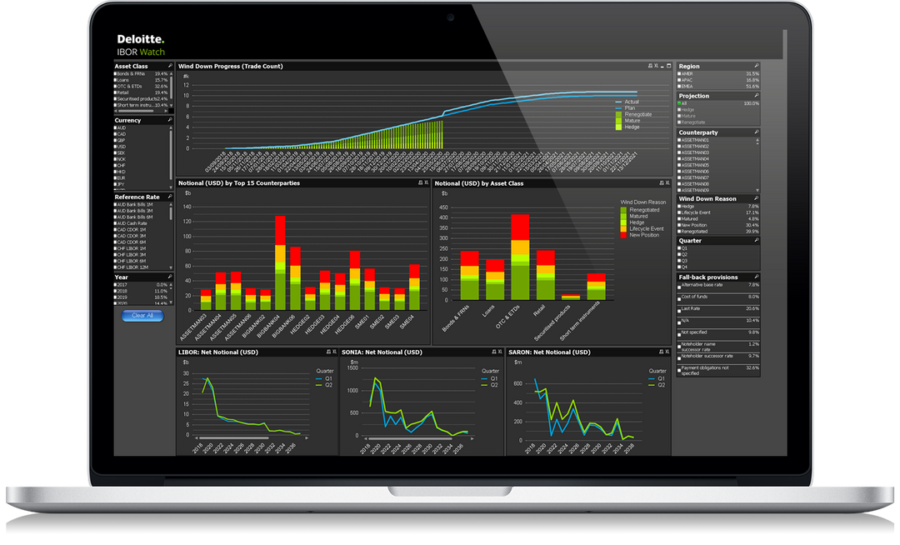IBOR reform
Navigating an uncertain and constantly changing regulatory landscapeTransition away from the London Interbank Offered Rate (LIBOR), and other IBORs, represents one of the biggest challenges facing financial services firms. Successful management will require significant change and strategic risk management – from adjusting risk profiles and models to navigating an uncertain regulatory landscape.

The future of IBORs
LIBOR, once known as the world’s most important number in finance, underpins contracts affecting banks, asset managers, insurers and corporates estimated at $400 trillion globally across most national currencies. Yet despite being one of the most significant reference rates used by financial market participants, the last financial crisis revealed its inadequacies.
LIBOR regulators (including the UK Financial Conduct Authority and the US Commodity Futures Trading Commission) have since announced a transition away from LIBOR, and towards alternative risk-free rates (RFR).
The FCA has made clear that, at the end of 2021, it will no longer seek to persuade, or compel, banks to provide LIBOR submissions. Other regulators have made similar statements and commitments.
RFRs have been agreed for all LIBOR currencies, and industry coordinated efforts in support of the transition to these rates has commenced, including the establishment of working groups to facilitate the required response. Yet some regulators have flagged that the transition is not happening fast enough. Further to this, while LIBOR may be the most significant Interbank Offered Rate (IBOR), transition away from other IBORs is also on the regulatory agenda.
Undertaking this change could bring considerable cost and risk to firms, but early planning and an understanding of how to manage the impacts to promote an orderly transition, limit disruption, mitigate operational risk and minimise cost.
$400 trillion in financial products is underpinned by LIBOR. Bank of England 'Financial Stabililty Report, August 2020 “Firms that we supervise will need to be able to demonstrate to FCA supervisors and their PRA counterparts that they have plans in place to mitigate the risks, and to reduce dependencies on LIBOR.”
IBOR Impacts
See the impact
Continuing to issue new LIBOR-linked contracts, which mature post-2021, when alternative RFR products have become a viable option, will lead to avoidable growth in exposures, and increases in associated risks.
Take action
- Establish a strategy and target for reducing LIBOR exposures in line with regulatory expectations
- Consider how best to build demand for RFR-linked products
- Put in place the capabilities to monitor and manage LIBOR exposures
See the impact
- A lack of liquidity may mean that firms are unable to build a curve and price products effectively
- Clients may be reluctant to transition to RFR products
- Issues for the firm itself in relation to appropriate hedging
Take action
- Monitor liquidity on legacy LIBOR and new RFR-linked products across jurisdictions
- Decide whether to contribute to RFR liquidity by issuing RFR-linked products
- Assess whether a forward-looking term rate is essential for your client base, or can clients transact in an “in arrears” RFR
See the impact
Insufficient and uncoordinated training on new RFR products and transition impacts could lead to conflicting messages from different business areas. Further, frontline staff could promote products in a way which is not aligned to firm strategy, or one business area could switch to an RFR without considering the implications for another (e.g. hedge accounting issues).
Take action
- Implement an internal communications strategy
- Consider rolling out training programmes, leading practices and a “red-flag” system, which highlights key issues employees should consider before taking action or triggers a process by which to escalate certain issues
See the impact
Transitioning the reference rates for products could create winners and losers – with one party paying or receiving more or less. If the process is not managed appropriately and transparently, clients could file complaints or claims of unfair treatment. This risk is heightened as firms are likely to have greater insights than clients into the advantages and disadvantages of transition.
Take action
- Establish a clear client communication strategy
- Have a system in place to distinguish between client types and sophistication
- Ensure disclosures are clear, fair and not misleading
- Ensure clients understand the risks of continuing with LIBOR contracts
- During client discussions, ensure all options and potential replacement rates are explained in full to clients to allow them to arrive at their own decision
- Educate existing and new clients on the advantages and disadvantages of using RFR products
See the impact
There is a significant risk of contract frustration if fallback provisions in standard-term legacy contracts, which are unsuitable for the event of permanent LIBOR discontinuation, are not updated to provide robust contractual protection.
Take action
- Analyse contractual language and affected counterparties early
- Amend contracts to address permanent discontinuation scenario
- Ensure compliance with EU BMR and adopt the updated ISDA protocols to manage the LIBOR transition more effectively
See the impact
Counterparties will need to assess whether a reference rate replacement for a legacy contract constitutes a substantial modification and therefore ‘derecognition’ under IFRS. Firms will need to consider whether a change in a hedging instrument’s terms will lead to a cessation of the hedge relationship and assess any implications for designated cash flow hedges that hedge LIBOR cash flows beyond transition.
Take action
- Identify instruments that might be affected by accounting issues
- Consider whether repapering is needed and evaluate how existing hedges might be affected by this
- Educate staff and engage clients to ensure implications are understood and required responses are put in place
See the impact
In certain jurisdictions, changes to existing contracts, if considered material, may constitute a disposal of the existing contract and entering into of a new contract for corporation tax purposes.
Take action
- Consider whether tax events would be triggered by existing terms and conditions
- Identify tax implications associated with repapering (i.e. review amendments to contracts together with envisaged accounting treatment)
- Review any new intra-group arrangements from a transfer pricing perspective
See the impact
Changes to firms operating models are expected to be significant given the extent to which LIBOR is likely to be embedded in systems and processes. Firms should also identify areas where there are LIBOR dependencies and potential complications in meeting regulatory rules. (E.g. lack of liquidity in new RFR or legacy IBOR benchmarks may impact use of internal models to calculate regulatory capital requirements).
Take action
- Ring-fence sufficient time and resource to identify and make operational changes
- Ensure core banking systems and operations are updated to support the processing of RFRs
- Include broader impacts, and consider wider rules, such as margin requirements and the Fundamental Review of the Trading Book, in the initial impact assessment
See the impact
Despite recent legislative changes to grant certain regulators mandates to enforce an orderly switch away from IBORs, the responsibility for active transition lies with market participants. There is not a uniform approach when it comes to conventions and best practices across geographies. Should firms fail to engage actively, they could face serious delays and severe penalties.
Take action
- Educate senior stakeholders on why it is essential to mobilise and fund a programme
- Engage with industry working groups, central banks and regulators
- Keep plans documented throughout and maintain progress dashboards for use in stakeholder engagements
See the impact
The retirement of LIBOR is the first step in a series of reviews of forward-looking benchmarks. Many other jurisdictions are introducing alternative RFRs and deprecating their existing forward-looking rates. Firms should continue to monitor the global efforts to reform interest benchmarks, review their exposures to other IBORs and determine their appetite to adopt alternative rates. Should firms fail to do so, they could face serious long-term consequences.
Take action
- Have a clear strategic plan of action regarding portfolios and exposures to other IBORs and benchmarks
- Apply lessons learned from the retirement of LIBOR to the transition of other IBORs
- Monitor benchmark reform effort across other jurisdictions
Deloitte IBOR Watch
Build your IBOR analytics capability with Deloitte’s IBOR Watch
To help firms design and guide their IBOR transition programmes, we have developed the IBOR Watch tool to support firms at each stage of transition planning, offering views of:
- Exposure identification
- Risk scoring
- Scenario analysis
- Market developments
- Financial impacts
- Wind down position tracking
- Steering Committee summaries
By using IBOR Watch, clients will be able to better understand the scale of their IBOR exposures and have greater confidence in moving to alternative risk-free rates.
Key dates
Navigate the important milestones and deadlines firms need to keep abreast of with our timeline.
Expected
Known
Notes:
Users of the Deloitte LIBOR timeline tool should be aware that it is updated, on a best effort basis, quarterly and was last updated on the date shown in the ‘Last updated on [date]’ timestamp at the top of this page; regulatory changes subsequent to this date will not be reflected.
The Deloitte LIBOR timeline tool is not intended to serve as legal advice and is provided for informational purposes only and therefore cannot be relied on to cover specific situations. The use of this tool does not guarantee compliance with any local or international law or regulation. It is not intended to form the basis of any decisions and you should not rely on its content for any purposes whatsoever. Deloitte LLP accepts no duty of care or liability for any loss occasioned to any person acting or refraining from action as a result of using this tool.
How you can act now
Convince stakeholders of the scale and complexity of LIBOR reform, and the need to understand the impacts now.
Engage the right people across business divisions and geographies and define the role of the central / core programme team – ‘thick’ vs ‘thin’.
Determine financial exposures, consider transition scenarios, identify operating model impacts and prepare implementation plan.
Update fallback provisions for new trades / contracts and agree the timing of switching to products linked to RFRs.
Track buy-side intent in moving away from LIBOR, educate and manage customers, and understand how the market is responding to conduct and competition issues.
Educate sales teams on the transition strategy so they can understand the implications of LIBOR transition in their interactions with customers and be ready to guide customers through the transition.
The latest analysis
Stay up-to-date on the latest LIBOR and IBOR transition developments and what your firm needs to do to ensure readiness.
Get in touch
Our team are working with firms across the industry to assist them with their IBOR transition. To find out more and how firms are readying themselves for the change, you may wish to submit a formal Request for Proposal (RfP).
IBOR reform experts
EMEA

Ed Moorby
Partner (UK), Financial Services Risk Advisory

Stephen Farrell
Audit & Assurance Partner

Mark Cankett
Partner (UK), Financial Benchmarks Assurance and Advisory

Russell Hulett
Partner (UK), FSI Finance Transformation Consulting
Americas

Nitish Idnani
Partner (US), Risk and Financial Advisory

Alexey Surkov
Partner (US), Risk and Financial Advisory

Clifford Goss
Partner (US), Risk and Financial Advisory

Craig Brown
Partner (US), Risk and Financial Advisory
Asia

Brian Chan
Partner (HK), Banking & Capital Markets Audit and Assurance

James Polson
Partner (HK), Banking & Capital Markets Audit and Assurance

Lapman Lee
Partner (HK), Banking & Capital Markets Audit and Assurance

David Roberts
Partner (Singapore), Banking & Capital Markets Audit and Assurance
